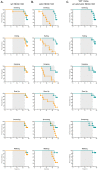Gene delivery corrects N-acetylglutamate synthase deficiency and enables insights in the physiological impact of L-arginine activation of N-acetylglutamate synthase
- PMID: 33574402
- PMCID: PMC7878489
- DOI: 10.1038/s41598-021-82994-8
Gene delivery corrects N-acetylglutamate synthase deficiency and enables insights in the physiological impact of L-arginine activation of N-acetylglutamate synthase
Abstract
The urea cycle protects the central nervous system from ammonia toxicity by converting ammonia to urea. N-acetylglutamate synthase (NAGS) catalyzes formation of N-acetylglutamate, an essential allosteric activator of carbamylphosphate synthetase 1. Enzymatic activity of mammalian NAGS doubles in the presence of L-arginine, but the physiological significance of NAGS activation by L-arginine has been unknown. The NAGS knockout (Nags-/-) mouse is an animal model of inducible hyperammonemia, which develops hyperammonemia without N-carbamylglutamate and L-citrulline supplementation (NCG + Cit). We used adeno associated virus (AAV) based gene transfer to correct NAGS deficiency in the Nags-/- mice, established the dose of the vector needed to rescue Nags-/- mice from hyperammonemia and measured expression levels of Nags mRNA and NAGS protein in the livers of rescued animals. This methodology was used to investigate the effect of L-arginine on ureagenesis in vivo by treating Nags-/- mice with AAV vectors encoding either wild-type or E354A mutant mouse NAGS (mNAGS), which is not activated by L-arginine. The Nags-/- mice expressing E354A mNAGS were viable but had elevated plasma ammonia concentration despite similar levels of the E354A and wild-type mNAGS proteins. The corresponding mutation in human NAGS (NP_694551.1:p.E360D) that abolishes binding and activation by L-arginine was identified in a patient with NAGS deficiency. Our results show that NAGS deficiency can be rescued by gene therapy, and suggest that L-arginine binding to the NAGS enzyme is essential for normal ureagenesis.
Conflict of interest statement
The authors declare no competing interests.
Figures









References
-
- Brusilow, S. W. & Horwich, A. L. Urea cycle enzymes. In The Metabolic & Molecular Bases of Inherited Disease (eds C. R. Scriver, A. L. Beaudet, W. S. Sly, & D. Valle) Vol. 2, 1909–1963 (McGraw-Hill, 2001).
-
- Ah Mew, N., Simpson, K. L., Gropman, A. L., et al. Urea cycle disorders overview. 2003 Apr 29 [Updated 2017 Jun 22]. In GeneReviews® [Internet] (eds M. P. Adam, H. H. Ardinger, R. A. Pagon, et al.) (University of Washington, Seattle, 1993–2021).
Publication types
MeSH terms
Substances
Supplementary concepts
Grants and funding
LinkOut - more resources
Full Text Sources
Other Literature Sources
Molecular Biology Databases
Miscellaneous

